COLUMNS
CHALLENGES
27 October, 2013
Crete-from the northern winds of the sea of Crete to the flame of the Libyan land
The "Pachia Ammos" settlement in the sea of Crete.
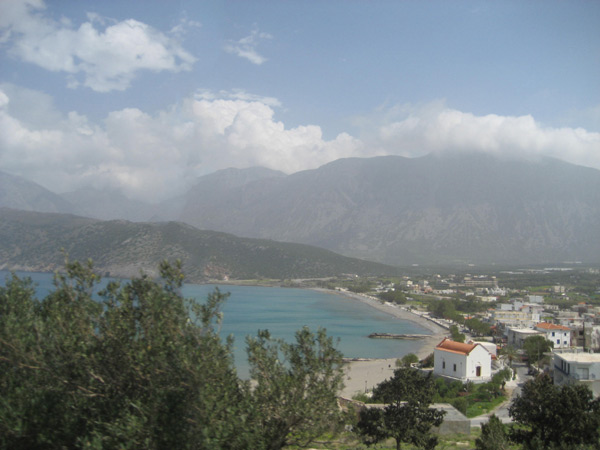
The Pachia Ammos settlement from the Gournia hill with view of Thripti Mountain. (Photo from the National Road Sitia - Ag. Nikolaos).
Early July. Watching outside the dry weeds and the all green olive trees in the fertile valley of the small rural settlement of "Pachia Ammos", built in the Sea of Crete with the cliffs, behind which the ancient Minoan city of Gournia was built (1), getting white amid the blue sky and the white of the plastered houses that climb up the side of the hill, I feel happy as the morning sun rises and the cliffs begin to steam up...
The excavation of Gournia is unusual as the American female archaeologist Boyd Hawes (2) came alone without husband in 1901 until 1904 to Greece. She dug along with her female collaborators and due to her knowledge of ancient Greek she organised its residents in the model of a democratic ancient Greek city (2). I presume the ancient Greek accent of the settlement's name is such due to her.
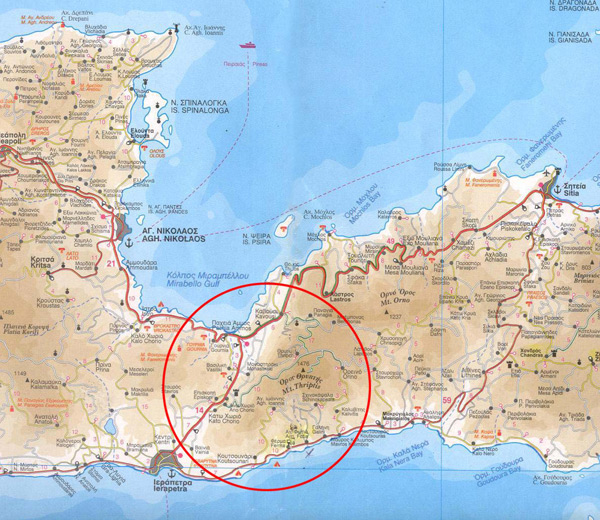
At night we slept with an open window, listening to the waves crashing deep, slimy in the shallow bay of Pachia Ammos. Rhythmic waves sound this morning as well, once the sounds of the wind quiet down. A cactus, a "yucca" of love, has blossomed... Stalks of small white bells are hanging from a stem in all directions. Open, they grace the top of the cactus.
The breeze makes the branches of the olive trees, of the palm tree and the tall hibiscus of the garden sway, like a summer symphony. Even the large Norfolk Island Pine tree top is slightly swaying, whilst its branches are moving like they are in an aquatic landscape: freely up and down. Only the flowers of the "yucca" almost stand still, relishing the chill in the landscape.
Blossoms of yucca
enjoy and relish the chill
the light zephyr wind.
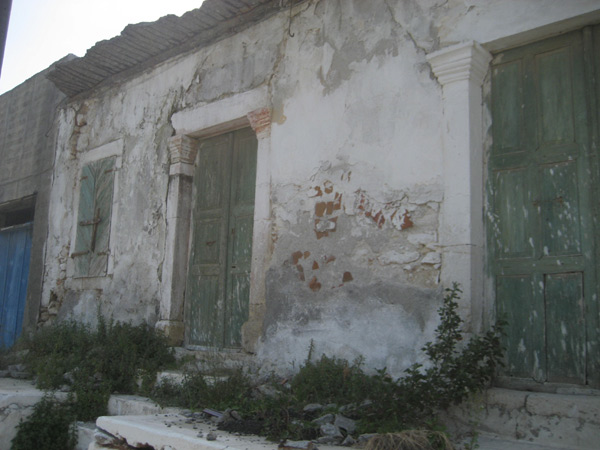
Eastward across from me the holy peaks of "Thripti" Mountain (3) liven up an illogical scenery. The sunrise shows off the hillsides of "Thripti" with its freestanding masses "worn", as they fade softly to the level of the sea. The mountainous masses far behind it are arid, treeless with steep slopes as they part while they open out northward to the Sea of Crete. We will pass by those mountainous masses the name of which is "Orno"- from the Greek word "Ορεινός" which means mountainous- in the afternoon to drive up to Sitia and from there to Toplou Monastery. My friend's house, where I live, is built westward the mound where the Gournia hill starts. I have a panoramic viewpoint of the valley from here.
I came all this way!
You offered the key to me
I am so grateful.
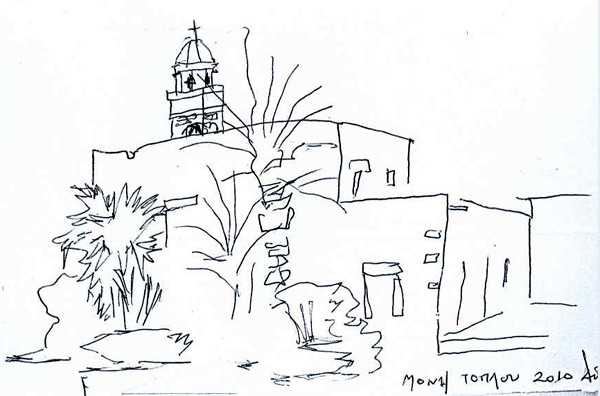
The marginal distance between the northern and southern side of Crete is at this point of the small valley that goes on from the Mirabello Bay of the Sea of Crete to Ierapetra of the Libyan Sea. The distance is no longer than 15 kilometers and the road following is an almost completely straight path.
Circumventing the town of Ierapetra one will be led eastward to the fiery beaches: Ferma and Agia Fotia...
These peaks are holy!
The great mountain of Thripti.
It protects and warms.
THE BEACH OF LIBYAN SEA "AGIA FOTIA"
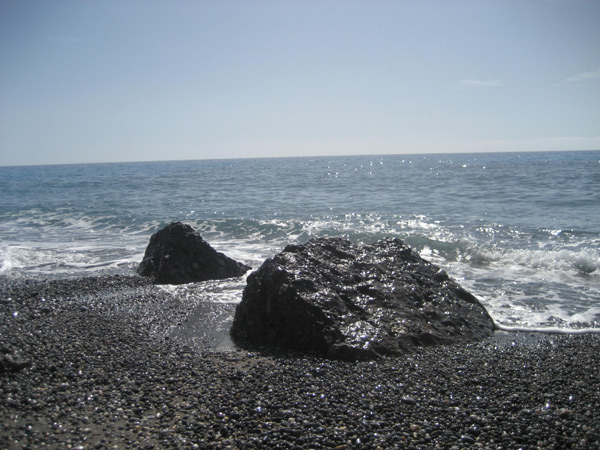
I'm going back to Agia Fotia! The beach after Ferma!
Who said that this scenery is not sacred?
I remember this beach with the sunset. August 1993. Saltcedars on the beach are now cut. A slightly raised formation with rocks forms now a new level. An outdoor wooden coffee bar has been mounted there. Chairs in rows on the beach sand. A group of men sitting there chatting, forming a shape of a round pebble and talking loudly.
I scan the scenery!
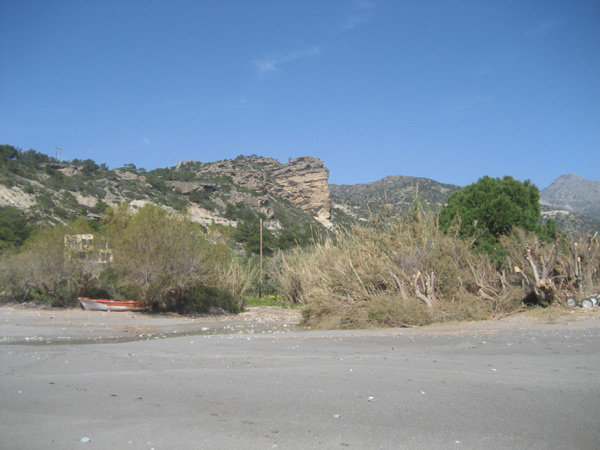
The large saltcedars under which we used to put up our tents are now badly cut. The old tavern now has a second floor with rooms for renting and a huge canopy has been built for providing services in the coolness of the shade. Built on the abutment of the road that leads to the beach. More rooms for renting have been built on the cliff.
The huge boulders seem like they have fallen from high up, from the enormous rocks. They are made of dense materials of sand and round black pebbles, product of erosion by strong winds that cross constantly the ravine and come from the north, from the Aegean Sea. Boulders come up around the small ravine with the river and the greenery around the landscape. Small old farmhouses built on the natural ravine and a chapel: Agia Fotini. I know! The people of Crete keep on living with their ancient pagan tradition. "Agia-Fotia" became "Agia Fotini" and it's the fire of Libyan Sea that was worshiped once like nowadays in the ancient Ierapetra...
A huge hard boulder resembling flame spring from the rocks beside the tarmacked road. The horizontal layers of its materials are visible because of the variation of its colours: garnet of the earth, brown, shades of ochre and limestone grey. The boulders of the ravine "crown" the scenery of the sea (4).
Beautiful children now play by the sea.
Their parents repose calmly on the loungers under the shadow of the thatched umbrella, whereas Cretan women play along with their children with a ball and swim in the sea. Cretan mothers with a sleek, graceful motion in their moves.
As soon as I dive into the water I figure out that something in it makes the rocks hot, the open sea steaming and the landscape holy!
The sea water has a quaint sweetness.
The waves of the sea are quaint as well.
The Libyan Sea!
Umbrellas and sand
the warmth of the sun, loungers
steams of Libyan Sea.
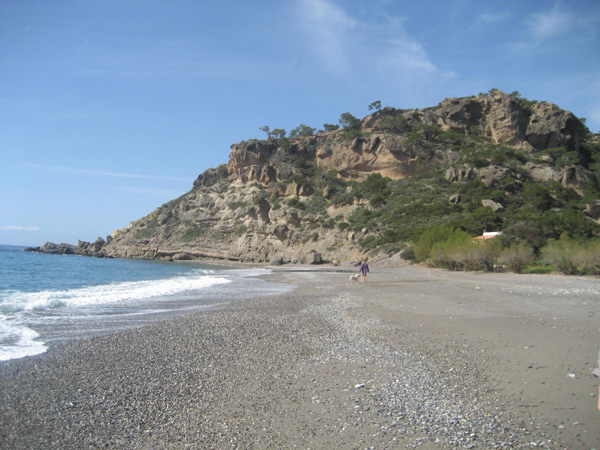
"Agia Fotia" beach of the Libyan Sea
Epilogue
Right before the Greek legislative election of May 2012 the existence of vast quantities of hydrocarbon and oil under these waters became known, in this area of the Mediterranean Sea that starts from Ierapetra and expands to Egypt and Cyprus. So, unfortunately, the ancient civilisations within these deposits will be involved in particular circumstances without any national security and may suffer the consequences of the existence of those deposits.
I'm worried that an environmental damage to this virgin environment alongside the impact of the economic crisis will lead to an extensive environmental disaster in southern Crete. It is the first time a significant undersea mineral deposit is found in Greece, except the case of Thassos. What we know up to now is that the deposits remain sealed for the Greek territory.
However, the utilisation of the hydrocarbon below the limestone layer, beneath the sand of the seabed, does not cause any significant damage to the environment. Also the long period of time of the utilisation of the hydrocarbon deposits may cause the drilling of the oil that there is under them to be unprofitable.
It is important, however, to know the particularity of our country, primarily of the places of outstanding natural beauty so as to protect its authenticity against international adversities.
by Anastasia Pepe, Architect Engineer
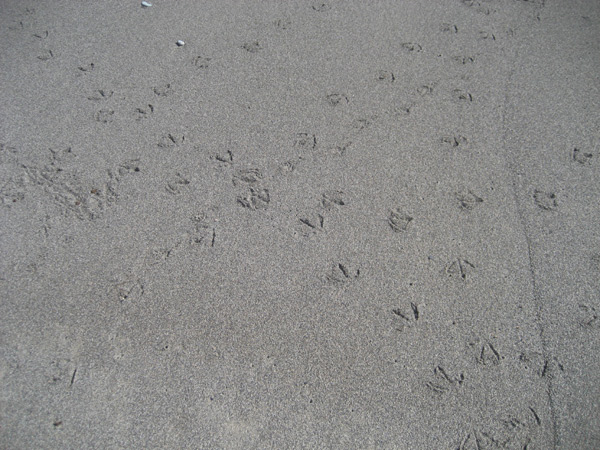
Ίχνη γλάρων στην παραλία Αγία Φωτιά.
REMARKS- BIBLIOGRAPHY
(1)The ancient Minoan city of Gournia is to this day the most well preserved Minoan city that developed in a highland region as a manufacturing capital from 1600 B.C. to 1450 A.D., which was destroyed from the Minoan eruption of Thera but once again dwelled. The palace compared to the others of Crete was small (1/10 of Knossos). In the following period a significant finding was this of a public sanctuary in a public space outside the palace with devotional objects of snakes - infernal gods and also birds.
(2)"Once women were prohibited from doing excavations- Today Archaeology is dominated by women" is the title of the article by N. Kodrarou-Rassia for the newspaper Eleftherotypia on 7th March 2013 regarding the latest book of Dimitra Kokkinidou "Women in Archaeology".
The archaeological site of Gournia was excavated in 1940 by one of the first women archaeologists in the world, the American archaeologist Boyd Hawes. She excavated in Gournia of Crete alone, with female collaborators, Blanche Wheeler and Edith Hall. Without approval from the director of the American School because she was a woman and without Evans' protection, she spent the money of her scholarship and excavated in Gournia using the local Cretan people as workers. She organized the community with "boule" and "citizen's assembly" in accord with the ancient Greek model of a democratic city, using the Ancient Greek language which she spoke well. I presume the ancient Greek accent of the name of the settlement Pachia Ammos is due to her.
(3)Thripti Mountain is a conservation area by the European Network Natura-2000 with code GR-4320005.
(4)"Wherever you see a beautiful landscape be sure that there is risk (seismic), because the beauty of the landscape was created by dynamic movements: Ionian Islands, Crete, the beautiful islands of our country. Otherwise it would be like Siberia. It would be a desert where nothing moves", the seismologist and member of European Parliament Stavrakakis G. noted. "The European tectonic plate has been detached and is sinking south of Crete" at a two-day conference on "Accidents, Disasters and Media District" in Chania of Crete. (May 2013).
Translation: Irene Pepe
Senior in Epirus Institute of Technology
Department of Applied Foreign Languages
Related articles:
- George Simaioforides 2002-2012 ( 23 April, 2013 )
- Industrial landscape in Aliveri ( 16 August, 2013 )
- Τhe cotton gin of lower. Tithorea at grandpa s old factory ( 22 July, 2013 )
- Edipsos ( 22 March, 2014 )
- Wooden single house in Dioni, Attica ( 13 March, 2014 )
- Kerameikos of Athens ( 16 October, 2014 )










